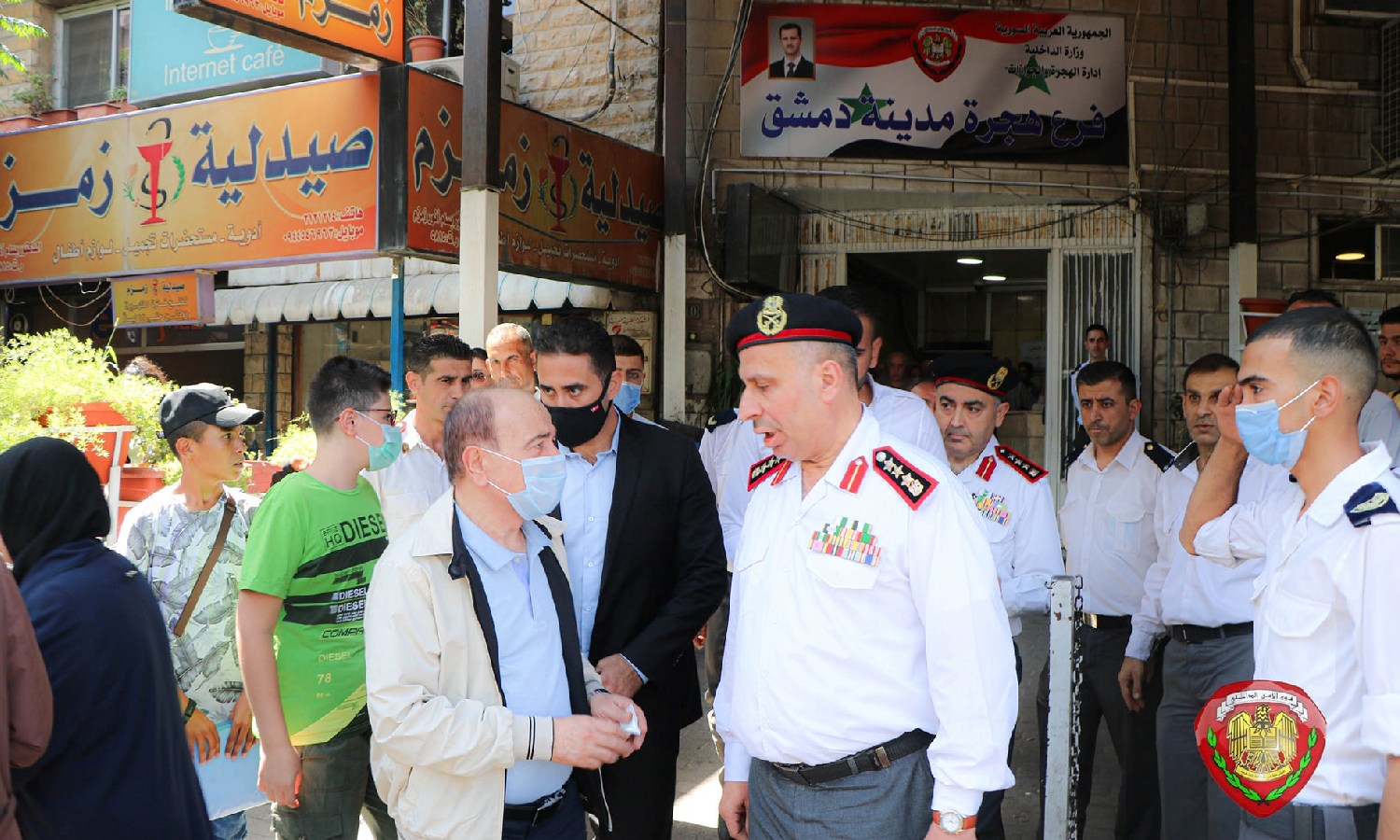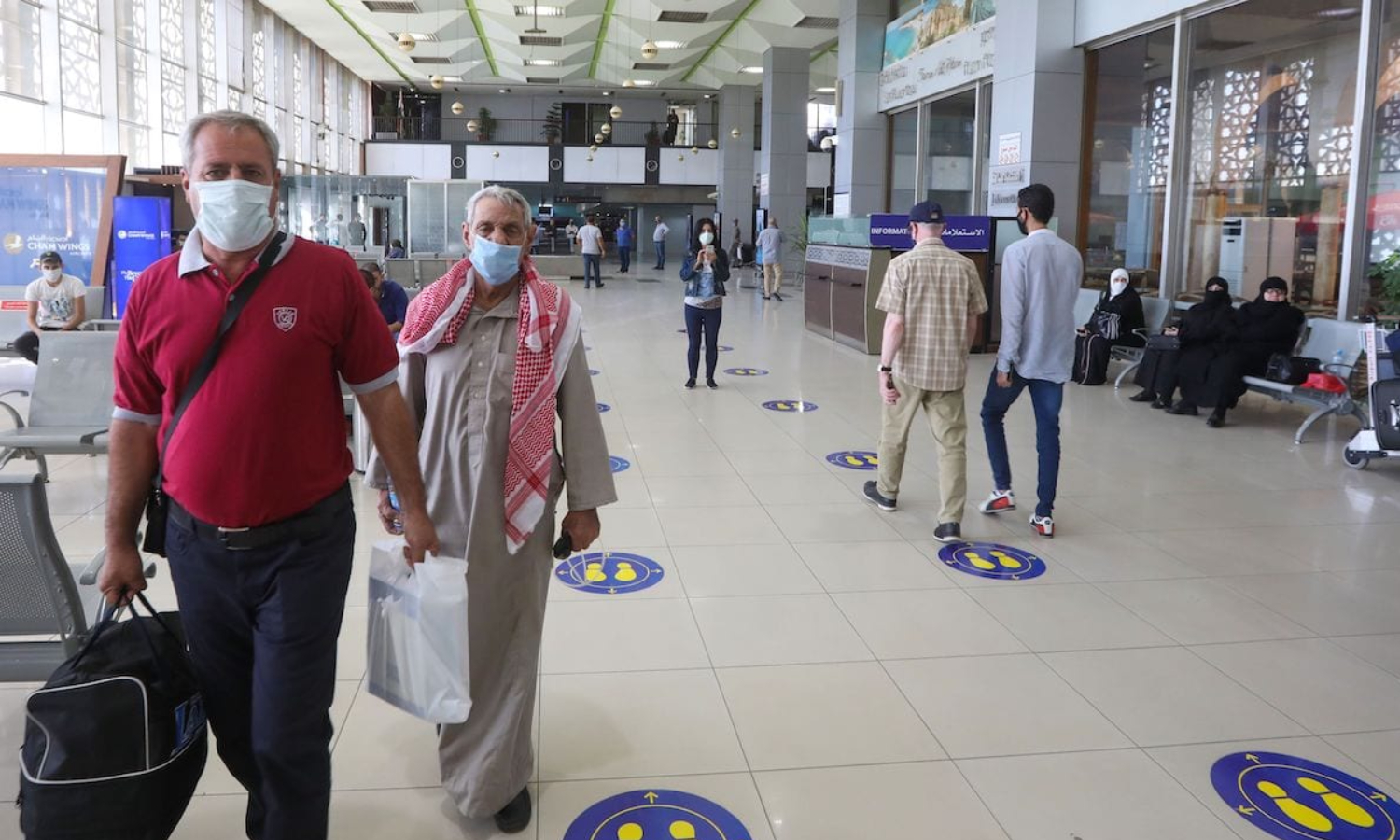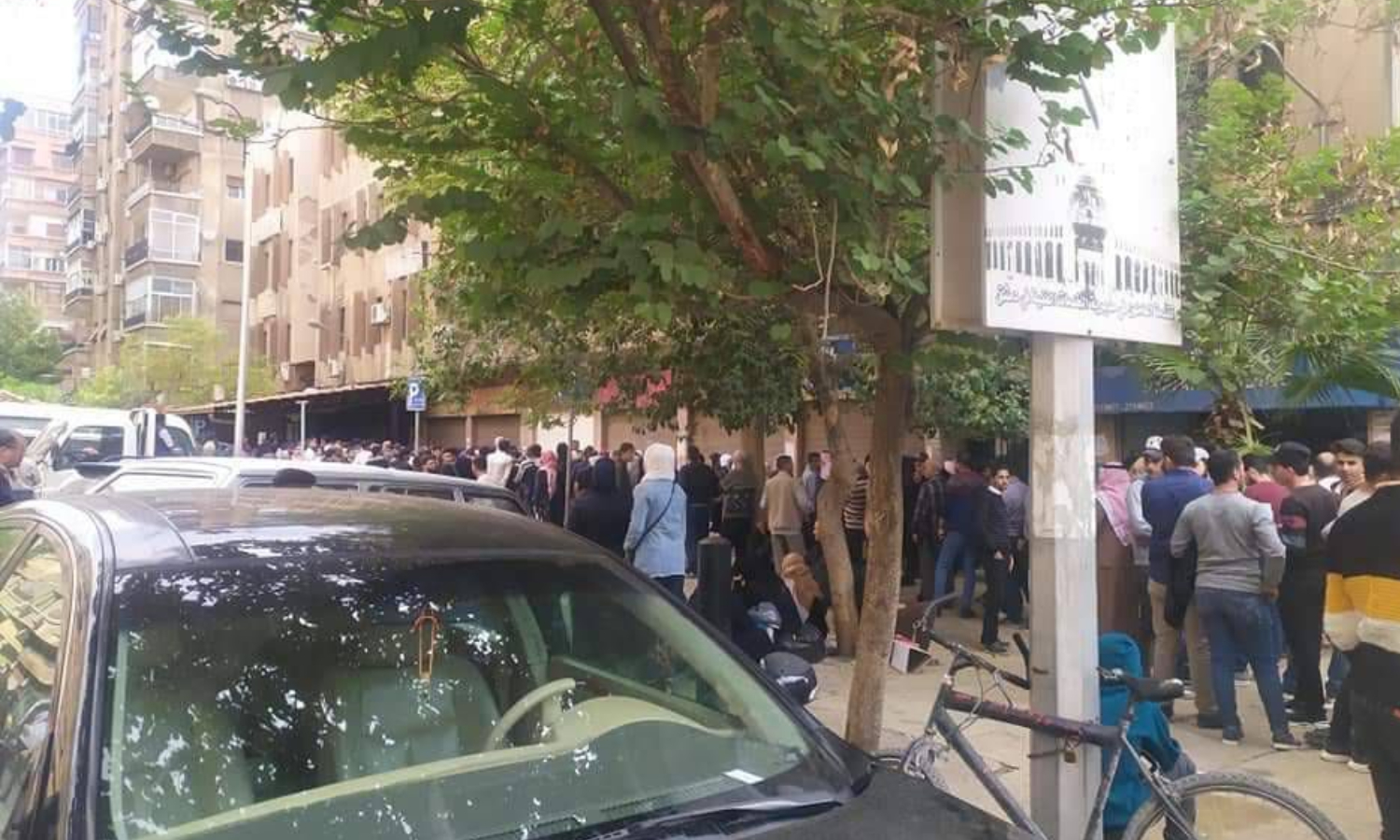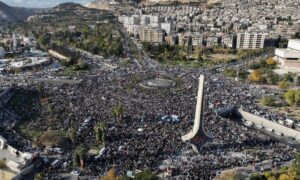Jana al-Issa | Diana Rahima | Amal Rantisi
“A year and a half have passed since the last time I bathed in our house. I used to shower at the hospital where I work due to the lack of hot water at home, and if any, my family would be standing in line to shower with hot water.”
With these words, Ghufran, aged 28, summed up the primary reasons that pushed her to leave Syria to Iraq in 2021, while Damascus, the Syrian capital, was witnessing a series of conferences sponsored by Russia for the return of refugees to Syria through the promotion of “enhanced” living and service conditions and portraying a “proper” environment for their return.
Ghufran, who requested Enab Baladi to withhold her last name for personal reasons, said that several reasons forced her to leave Damascus and her work as an anesthesiologist assistant at one of the Syrian capital’s largest public hospitals. She also quit her part-time job at more than one health center, sacrificing a monthly salary barely enough to afford a domestic gas cylinder at the price of the black market.
The continued power rationing during the last years, besides the countless crises experienced by Syrians in regime-held areas, has given rise to an acute sense of bitterness inside Ghufran and caused her to hate this life that is nothing like normal people’s lives, as she put it.
Ghufran’s emigration to Iraq is one of many similar escape journeys that Syrians took in 2021, which the Syrian government and its institutions refuse to admit or release official statements and figures about. Nevertheless, Syrian diaspora social media groups and independent research and study centers’ estimates revealed the actual scale of this problem.
Even with the emergence of images showing long queues of Syrians in front of emigration centers and despite the passport crisis and its ridic prices in regime areas, the Syrian government continues to call on refugees to return home by holding three refugee return conferences under Russian support and organization. These conferences, however, were dismissed by key actors in the Syrian refugee file.
In this in-depth article, Enab Baladi addresses the Syrian regime and Russia’s attitude towards the return of Syrian refugees and the regime’s continued efforts to advertise “improved” living conditions despite the dim reality in its regions. Enab Baladi also presents the views of many Syrian political and economic experts on the interests sought by the regime and Russia behind refugee return.
Three fruitless conferences in Damascus
In less than a year and a half, the Syrian regime and Russia held three conferences calling on Syrian refugees to return home.
The first conference was held in November 2020 in Damascus under Russian sponsorship and was accompanied by extensive media coverage by Syrian regime-affiliated media and Russian media outlets.
The so-called “International Conference on the Return of Refugees” was attended by countries hosting limited numbers of Syrian refugees, including Pakistan, Venezuela, Brazil, Somalia, the Philippines, Algeria, Iran, India, and North Korea.
The conference caused public outrage and condemnation among opponents, activists, and human rights organizations, as over 33 Syrian organizations and entities signed the launching statement of a campaign called “No Return with al-Assad,” in which they affirmed, in addition to the condition of al-Assad’s departure, the necessity to stop the regime’s bombing of northern Syria, complete political transition, release detainees, provide a safe environment, and start reconstruction, as other conditions for the voluntary and dignified return of refugees.
Syrian social media users posted on Facebook and Twitter to respond to the regime’s claims of a safe environment for the return of refugees under the hashtag “no return with al-Assad.” They published texts, images, and recorded videos of detainees still in detention centers as an indication that the regime has no real guarantees of a safe environment for any refugee who opposes the ruling power in Syria.
Two conferences in 2021 for refugee return or enhancing joint cooperation?
Despite the broad rejection that met the first conference on refugee return and the non-provision of any of the requirements necessary for “safe return,” Russia continued to push towards this trend through successive meetings by Russian delegations in Syria.
In mid-November 2021, the regime government held a Syrian-Russian joint meeting to follow up the work of the International Conference on the Return of Refugees. The meeting failed to produce any concrete efforts that could facilitate the return of refugees, while Syrian and Russian media focused on highlighting the two sides’ joint cooperation agreements.
According to the Russian state-owned Sputnik news agency, the three-day meeting’s agenda was predominated by “cooperation projects” in different sectors, including health, media, housing, local administration, electricity, higher education, agriculture, and industry.
The state-run Syrian Arab News Agency (SANA) published that the joint meeting was planned to include a session for the Syrian and Russian Ministerial Coordination Body, in the presence of representatives of the United Nations (UN), the International Committee of the Red Cross (ICRC), and other humanitarian organizations.
The Syrian regime and Russia claim that their joint agreements are held for the purpose of “creating proper living conditions for refugees and supporting reconstruction projects.” However, in reality, these agreements reflect Russia’s ambitions of domination over Syrian economic sectors that might prove profitable in the future.
In July 2021, the Russian Defense Ministry announced that “Damascus will host a meeting by the Russian-Syrian Interdepartmental Coordination headquarters for the repatriation of refugees and the restoration of peaceful life,” under a decision from the Russian President, Vladimir Putin, and the Russian Defense Minister, Sergey Shoygu.
The Russian Ministry of Defense said at the time that the meeting is aimed at “giving further impetus to resolving humanitarian problems in Syria and promoting the implementation of Russian-Syrian agreements reached in November 2020 (during the International Conference on the Return of Refugees to Syria).”
False claims of safe and dignified return
Syrian Minister of Foreign Affairs and Expatriates Faisal Mekdad vowed that his country will ensure a safe environment and decent living conditions for returning refugees.
During the July Russian-Syrian joint meeting, Mekdad stated that the Syrian refugees return issue is being “politicized by western countries.”
However, Mekdad’s optimistic statements about ensuring a decent living for returning refugees contradicted human rights organizations’ reports warning that it is still unsafe for refugees to return to Syria.
In a report published on 20 October 2021 by the Human Rights Watch (HRW) under the title “Our Lives Are Like Death, Syrian Refugee Returns from Lebanon and Jordan,” the HRW warned against misinformation on the reality of life inside Syria.
The report pointed out that the actual reality in Syria has influenced the decisions of many of the refugees that HRW interviewed to return.
In 2018, the General Security Organization (GSO), the Lebanese security agency responsible for the entry and exit of foreigners, began facilitating returns for refugees to Syria, the report mentioned.
As part of the process, the GSO obtained a “security clearance” from the Syrian authorities for any refugee who wished to sign up for a return movement, it added.
The HRW interviewed Yasser, 32, from Homs, who believed the security clearance would guarantee his safety on return to Syria. “I had been promised by the Lebanese GSO that no one would be harmed when returning. They said the security clearance had been done, so it would be safe for me on return,” he said.
However, according to the report, Yasser was detained by the Syrian Political Security Agency just a day after his return and endured four months of arbitrary detention and brutal torture.
The HRW also interviewed people who said that they relied on information from media outlets or friends and relatives who returned before them and described the situation in ways often contradictory to reality.
Many people told the HRW that they were not prepared for the level of economic difficulties they faced in Syria, nor the physical destruction of their home and area.
Regime officials, including the Minister of Foreign Affairs Faisal Mekdad, described testimonies and reports put together by human rights organizations as “misleading practices to distort reality inside Syria through the promotion of resettlement instead of return for Syrian refugees.”

Syrian Minister of Interior, Mohammad al-Rahmoun, talking to citizens in front of the Immigration and Passports Directorate in Damascus (Syrian Ministry of Interior)
Overstated numbers of returning Syrian refugees
The numbers announced by regime officials and Russia on refugees returning to Syria are inconsistent with the real numbers documented by the United Nations High Commissioner for Refugees (UNHCR).
In mid-November 2021, the head of the Russian-Syrian inter-agency coordination headquarters for the return of refugees and the president of the Russian National Defense Management Center, Mikhail Mezentsevthe, said that over two million and 326,000 persons had returned to Syria, of which a million and 373,000 are internally displaced, while over 952,000 refugees are from outside the country.
Months earlier, Syria’s Minister of Local Administration and Environment, Hussein Makhlouf, stated that the number of Syrian refugees returning from abroad to Syria is nearly 1.1 million and that over five million internally displaced persons have also returned to their areas.
However, recent statistics published by the UNHCR showed that approximately 282,283 Syrian refugees returned voluntarily to Syria between 2016 and May 2021.
According to the UNHCR, 2019 witnessed a large wave of voluntary repatriation to Syria, with 94,971 returnees in this year alone.
Propaganda or hidden interests?
Why is Russia pushing towards the refugee return file?
The regime and Russia’s determination on refugees’ return raises questions about their actual position on refugees and the benefits they seek to achieve through this file, which became at the top of their meetings’ agendas.
Enab Baladi conducted an opinion poll on its social media platforms, in which 36 percent of participants said that the return of refugees to Syria is in the interest of the Syrian regime, while 64 percent said that the regime would benefit more if refugees remain abroad.
Russia uses refugee return cards to legitimize the Syrian regime
Syrian expert in Russian affairs, Dr. Nasr al-Yousef, told Enab Baladi that the regime and its backer Russia have a vested interest in refugee return to re-float and legitimize the regime in preparation for the launch of the reconstruction process and make economic gains.
Al-Yousef pointed out that the regime and Russia’s desired interest is far from being achieved, as refugee laws do not allow the returning of refugees to an unsafe country that could put their lives at risk.
The International Refugee Law (IRL) lists the major instruments on which international protection is based, encompassing two documents that constitute its cornerstone— the 1951 Convention and the 1967 Protocol.
These documents lay out provisions that prohibit returning refugees and asylum seekers to countries where they could be at the risk of persecution, safeguard their right to international protection under the principle of non-expulsion, and demand that all refugees be treated according to the principle of non-discrimination.
Refugees are usually granted asylum to escape life-threatening persecution, and any decision to return them involuntarily can be contested and challenged before the European Court of Justice because the return would be an explicit violation of the provisions of [the protection agreement].
Syrian regime prefers refugees to remain abroad
Dr. Mahmoud Hamza, a Syrian political analyst, and expert in Russian affairs told Enab Baladi that both the regime and Russia are exploiting the refugee issue in their return conferences by focusing on the humanitarian side of returning refugees to their homes.
However, the two sides’ primary interest is to obtain funding in order to attract international support for the rehabilitation of the regime, Hamza added.
Hamza explained that Russia is sponsoring the return of Syrian refugees to deliver a message to Europe that it is “the savior that will return refugees to their country and end the humanitarian crisis refugees caused to Europe.”
As for the regime, it is making no effort in the refugee return matter, as the regime’s president, Bashar al-Assad, seeks to structure a homogeneous society on a base of its loyalists only, according to Hamza.
Syrian regime cherry-picks well-off refugees
A distinction must be drawn between the stated desire of the Syrian regime, which is reflected in propaganda inviting Syrian refugees and displaced people to return to their homes, and its implicit aim of depicting Syria as “safe” for political gains, Syrian researcher and Ph.D. holder in Economics and research director at the Operations and Policy Center (OPC), Karam Shaar, told Enab Baladi.
According to Shaar, the regime is eying the return of investors and wealthy Syrians whose return would not burden the government financially.
Shaar referred to a study conducted by the UNHCR in February 2018, containing 22 protection thresholds and parameters necessary for the return of refugees to Syria, with the UN and refugee-hosting countries’ facilitations if all parameters were met.
However, under current circumstances, the UN is against the return of refugees to Syria because it considers that most of the parameters set for their return are not met.
There is no economic interest for the Syrian regime in the return of refugees in the broad sense, as their return will add substantial financial costs on its government, economic researcher at Omran Center for Strategic Studies, Mohammad al-Abdullah, told Enab Baladi.
According to al-Abdullah, large-scale repatriation requires the provision of basic necessities of life, such as livelihood means, education, health services, and other essentials the regime cannot provide.
Al-Abdullah added that the regime is unwilling and unable to afford the consequences of such a return for fear of a new wave of protests that could shake its pillars in case it fails to secure the living requirements of returning refugees.
Still, the regime craves the return of venture capitalists and business people who mostly left Syria to neighboring countries, al-Abdullah said.
Through its external economic networks, the regime endeavors to entice investors and businessmen to return to Syria and contribute to the reconstruction process. This appeared evident in statements by some figures associated with the regime and government measures linked to the refugee return file.
Reconstruction in Syria and refugee return
The refugee return file is one of the foundations for any international agreement to reach a political solution to the Syrian issue, and without it, the regime would not be able to initiate the reconstruction process.
Reconstruction in Syria would allow the regime to benefit from lucrative contracts through its economic networks and relations inside and outside Syria; therefore, the regime is promoting the return of refugees to please the international community in regard to this file.
Commenting on the reconstruction process and the argument by many that refugees should return to serve as needed labor, al-Abdullah said that the regime has worked over the past years to develop selective policies on which sectors to be targeted by the reconstruction process, namely non-production sectors.
Unproductive sectors do not require high costs or considerable labor force to be restored, unlike productive sectors like industry and agriculture. Non-productive sectors rely on imports, which the regime finds more economically beneficial than rehabilitating productive sectors in the first phase after reaching a political solution.
According to al-Abdullah, the regime seeks to realize an economic equation in the refugee return file. It tries to attract venture capitalists with their experience and economic relations while maintaining the cash flow coming from remittances in hard currencies from Syrian refugees residing in different parts of the world.
Al-Abdullah said that cash flows generated through external remittances kept the regime’s economy afloat over the past years. The regime also tried to seize properties of former residents in its areas, taking advantage of their absence and the chaotic situation in the country, by stipulating unjust laws that deprived many refugees of ever thinking of returning to Syria.
Crises in regime areas drive more Syrians to leave
The Syrian and Russian plans on refugee return, which were at the top of the 2021 agenda, did not go as intended.
As the regime called on refugees to return, more people in Syria were thinking about or have decided to leave due to worsening living conditions.
Successive living, economic, and security crises have exhausted Syrians living in regime areas since the beginning of 2021 and drove them to stand in long queues in front of immigration and passports directorates searching for a better and more dignified life.
The Syrian pound loses 24.7% of its value during 2021
The Syrian pound’s volatile exchange rate against the US dollar during the first four months of 2021 has weakened Syrians’ purchasing power due to price increases for key staples and foodstuffs.
In late 2020, the Syrian pound’s black market price reached 2,870 against the US dollar; however, after the Central Bank of Syria (CBS) issued the new 5000 note on 24 January 2021, the pound’s value witnessed another steep and unprecedented drop.
During the first four months of 2021, the Syrian pound’s value approached 5000 to the US dollar before it was stabilized in April 2021 at the price of 3,500 against the US dollar.
In the last days of 2021, the pound hit 3,580 against the US dollar, registering a loss of 24.7% of its value in a single year.
2021: The year of doubled prices. Some by over 600%
2021 witnessed day-to-day price increases under many government justifications, such as fluctuating exchange rates and US sanctions imposed on Syria, also known as the Caesar Act, which was often used by the regime government as a pretext for importation difficulties.
Most prices of food commodities, fuel, and services were doubled at the end of 2021, with some rising by over 600% than early 2021, amidst inadequate allocations of subsidized commodities distributed through the smart card system, causing families to purchase unsubsidized goods at costly prices, double those set by the regime’s government.
The price of a liter of subsidized gasoline rose from 450 Syrian pounds (15 US cents) to 1,100 Syrian pounds (30 US cents), while the price of a liter of diesel used for home heating reached 500 Syrian pounds (12 US cents) after it was 180 Syrian pounds (6 US cents) at the beginning of 2021.
The price of the household gas cylinder also rose to 10,450 Syrian pounds (2.9 US dollars), with an increase of about 294.3% over that of early 2021, which was 2,650 Syrian pounds (92 US cents).
The rising prices of fuel products essential for most food industries caused most staples’ prices to double, with an increase of 100% for regular bread, 614.2% for tourist bread, 100% for sugar and rice, and 148.3% for vegetable oil.
The increased fuel prices have also led to a 100% doubling in the fares of transport services (minibusses and Taxis) and caused some people working in the transport sector to quit their jobs to avoid additional financial losses. This created a temporary transportation crisis that disrupted everyday tasks, such as going to university or work.
In addition, the prices of all medicines available in Syria have risen by over 60% compared to early 2021.
The ever-worsening condition for electricity in regime areas
Over the past years, Syrians in regime areas sought to create solutions whenever possible to pressing living crises, but they could not secure an alternative to electricity.
The electricity sector, one of the most adversely affected sectors since the beginning of the Syrian war, did not witness improvement during 2021 despite government promises; instead, power rationing increased to the degree of continuous outages.
The regime government failed to find solutions to end the electricity crisis in its regions. Due to this failure, residents had to endure harsh weather conditions in winter and summer throughout 2021, despite the importance of electricity to industries and all life aspects.
As monitored by Enab Baladi, the power rationing that took place during 2021 was the worst in the past seven years, with many villages and neighborhood residents complaining that they had complete power cuts for days.
Many other regime areas suffered extended and daily power rationing of up to 23 hours against only an hour of electricity.
Two million a month to cover basic needs of a five-member family in regime areasA report by the online economic newspaper Kassioun published on 27 December 2021 showed that the average cost of living for a Syrian family of five has reached more than 2 million Syrian pounds (nearly 560 US dollars) a month. The report’s calculations were based on the daily cost of the necessary food basket per capita, representing about 60% of the overall minimum cost of living, while the remaining 40% represents other essential needs of the family (housing, transportation, education, clothing, health, household appliances, telecommunications, and others). A previous report by the same newspaper published at the beginning of 2021 said that a Syrian family of five needs an average amount of 732,000 Syrian pounds (about 255 US dollars) as a monthly income to cover their basic living requirements. |
Syria’s economic collapse is the main reason for emigration
According to a report by the Syrian Association for Citizens’ Dignity (SACD), published in late August 2021 and prepared during 2020 through communication with individuals residing in Syria, economic conditions are the main reason for wanting to leave regime-held areas.
The vast majority (about 89 percent of the 533 participants from different areas controlled by the regime ) reported dissatisfaction with the current situation in all aspects, whether security, living, economy, or services.
Nearly three-quarters (73 percent) of respondents believe it is impossible to achieve a decent standard of living in the current situation in regime areas.
The difficult living conditions in regime-controlled areas have led Syrians to seek an escape during 2021.
In the absence of specific official statistics on the number of Syrians who went abroad in 2021, Enab Baladi attempted to monitor statements about the emigration of certain categories of Syrians, as well as to monitor destinations that facilitated Syrian emigration requirements during 2021.
In early August 2021, the head of the textile sector in Damascus Chamber of Industry, Mouhanad Dadoush, talked about a “massive” exodus of “irreplaceable” industrialists from regime-held areas towards Egypt as a result of numerous difficulties, such as the lack of power necessary to run their facilities, low demand and purchasing power, and other challenges related to exportation difficulties.
In September 2021, the president of the General Union of Craftsmen, Naji al-Hudwa, announced a clear increase in requests for craft certificates by Syrian craftsmen to use them abroad.
In November 2021, the president of the Barbers and Cosmetology Association in Damascus, Mohammad Said al-Saadi, announced the closure of half of the beauty salons licensed by the Association for many reasons, mainly the emigration of workers to Erbil and the United Arab Emirates (UAE).
In December 2021, the president of the Dentists Syndicate in Latakia governorate, Tariq Abdullah, stated that about 70% of newly graduated dentistry students left Syria after registering themselves in the Syndicate for one year.
Syrians who emigrated or are thinking about emigration have all suffered from the severe living and economic crisis in regime-held areas and complained about their working conditions and low incomes.
As talks about a “massive” exodus of industrialists rose, the Syrian Ministry of Interior suspended the issuance of passports for “technical” reasons outside the Ministry’s control. The passport issuance crisis lasted for over three months.
Meanwhile, the former Minister of Economy, Lamia Assi, stated that the high demand for emigration for Syrian youth is confirmed by the overcrowding in immigration and passport branches, seeking to obtain a passport, noting that this represents a significant loss of youth power and competencies.
Will the normalization of ties between the regime and Arab countries affect the refugee return issue?
Several Arab countries, including Jordan, which hosts about 673,000 Syrian refugees, have recently re-established relations with the Syrian regime, initiated by a phone call from the Jordanian King, Abdullah II, on 3 October 2021 with the head of the Syrian regime, Bashar al-Assad, which was the first of its kind since 2011.
On 9 November 2021, the Foreign Affairs Minister of the United Arab Emirates, Abdullah bin Zayed Al Nahyan visited al-Assad in Damascus, accelerating the pace of Arab normalization with the regime.
Syrian expert in Russian affairs, Dr. Nasr al-Yousef, commented on the link between the normalization of relations with the regime and the Syrian refugee file by saying that if normalization steps became more comprehensive, they would impact the return of refugees to Syria, but the United States and European Union position will remain an obstacle to that end.
According to al-Yousef, the West abides by international humanitarian law standards that prevent the return of Syrian refugees to a country where they will be met with death or arrest.
The European Union (EU) refused to participate in the first refugee return conference held in Damascus in 2020 despite receiving several invitations. The EU High Representative for Foreign Affairs and Security Policy and the Vice-President of the Commission, Josep Borrell, emphasized that “The current conditions in Syria do not lend themselves to the promotion of large-scale voluntary return in conditions of safety and dignity in line with international law.”
Borrell cited the “limited” return cases documented during the last period as evidence that “reflects the many obstacles and threats to the return of refugees and displaced persons,” including “conscription, arbitrary arrests, and enforced disappearance.”
Iraqi researcher and expert in international relations, Dr. Omar Abdulsattar, told Enab Baladi that the Arab resumption of diplomatic relations with the Syrian regime would not impact the refugee return issue, the reconstruction process, or the re-acceptance of the Syrian regime.
According to Abdulsattar, the region has been plagued by two problems during the past decade: the Islamic State (IS) and the Syrian regime, and the region cannot move forward without finding solutions to these two problems.
Abdulsattar cited a speech by the former US Special Envoy for Syrian Affairs, James Jeffrey, entitled “The Future of Syria: Turkish and US Perspectives,” in which he said, “Syria is one of the most serious issues in the Middle East and the world, and Iran, Russia, the United States, Turkey, and Israel have a say in this issue.”
The researcher stressed that the fate of Syrian refugees is decided by US-Russian negotiations on Syria and not the Arab mending of relations with the regime.
This opinion is in line with statistics by the UNHCR on returning refugees to Syria during 2021, which demonstrated that despite the resumption of diplomatic relations between Syria and Jordan, only 2,249 refugees had returned voluntarily out of nearly 673,000 refugees registered by the UNHCR in Jordan.
As for Lebanon, which has good relations with Syrian officials and understandings on the refugee return issue, only 1,744 out of 844,000 refugees registered with the UNHCR returned in 2021.
The mentioned numbers on returning refugees reveal a decline in the return rate between 2021 and previous years, despite the improvement of political relations between the regime and several Arab countries.
Warnings of more displacements and emigrations for Syrians
A report by the Norwegian Refugee Council (NRC) warned that “The Syrian crisis could see at least 6 million more displacements over yet another decade if the conflict, insecurity and economic deterioration continue unabated in Syria.”
The report attributed the increasing numbers of displacements and emigrations to the lack of safety and opportunities in Syria, military operations, mass displacements, economic decline, and skyrocketing poverty rates.
A study by the Operations and Policy Center (OPC) published in May 2021 showed that the majority of sample respondents would want to leave Damascus and travel abroad if given the opportunity.
According to the study, escaping difficult living conditions in Syria was the main reason for wanting to emigrate, as stated by about 60% of the 381 respondents who expressed the desire to do so, which is understandable in light of the economic deterioration that Syria has experienced over the past decade, which has increased during 2019 and 2020.
Other factors affecting respondents’ desire to emigrate include the search for better employment and education opportunities, a desire to reunite and join family members outside Syria, and avoidance of compulsory military service.
The phrase “I am tired of living in Syria” was also a reason for some respondents to leave the country.
The study also showed that the lack of financial ability to cover emigration expenses is the most prominent factor preventing respondents from taking the step of leaving, as “weak financial resources are both a motive and a barrier to emigration,” and if money or less expensive emigration ways were available, “the desire may be turned into a decision.”
if you think the article contain wrong information or you have additional details Send Correction
النسخة العربية من المقال
-
Follow us :













 The head of the Syrian regime, Bashar al-Assad, and Russian President Vladimir Putin (edited by Enab Baladi)
The head of the Syrian regime, Bashar al-Assad, and Russian President Vladimir Putin (edited by Enab Baladi)





 A
A
A
A
A
A












 More In-Depth
More In-Depth